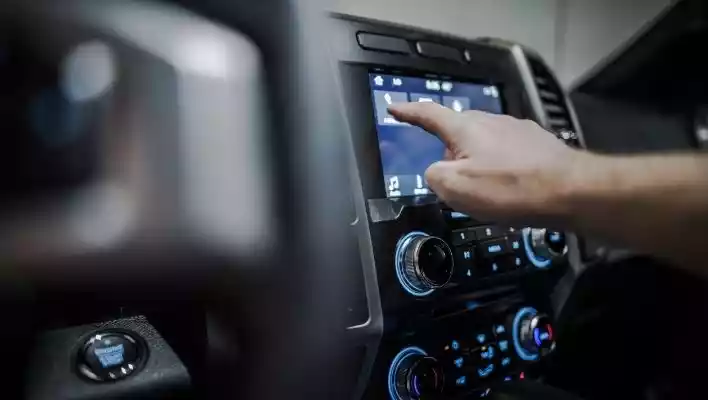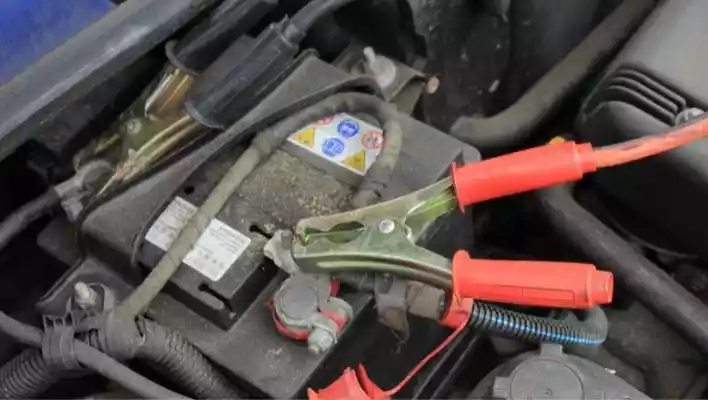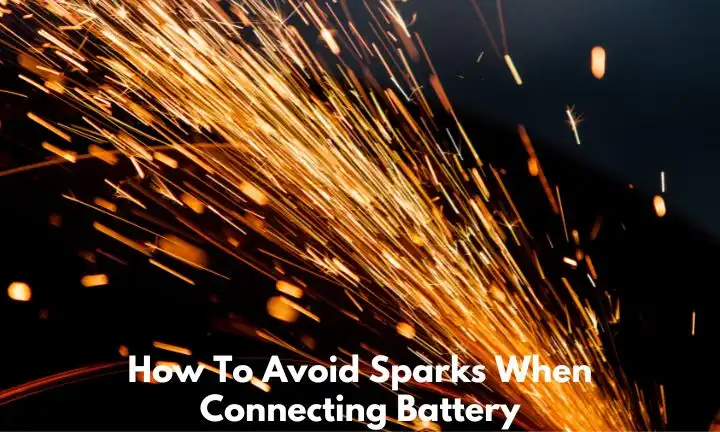Car battery sparks when connecting is a common scenario, but if your car battery is smoking or has loud pops when connecting, then you need to know the reason behind it.
Whether the car owners connect the new battery or disconnect the charger, they get easily scared by the sparks that come instantaneously.
But, as a car owner, you must have the proper knowledge regarding charging the battery, jumper cables sparking, battery positive and negative terminal, and more.
So, in the article, you will find some reasons why the battery is sparking when connecting, is sparking normal for cars when connecting, how you can avoid sparks when connecting the battery, and more.
Reasons Why A Car Battery Sparks When Connecting

Your car battery sparks when connecting because the cables are installed in the wrong order or your car has a short circuit in the electrical system. And proper cable placement is necessary to avoid sparking.
Four most common reasons why the car battery sparks when connecting:
- Cables are Installed in the Wrong Order
- Corrosion on Battery Terminals
- The car’s Electrical Components were Turned On
- Short Circuit in Car Electrical System
1. Cables are Installed in the Wrong Order
The most common reason why your car battery sparks when connecting is that cables are installed in the wrong order.
The wrong installation of cables came from the confusion since car owners are not charging their car batteries or jump-starting too frequently.
In terms of connecting the new battery and disconnecting the battery, you must know which car battery terminal to connect to first; otherwise, wrong order cable installation will cause large sparks or loud pops when connecting the battery.
When you connect the new battery, you first need to connect the positive and negative terminals. Also, Make sure the negative battery terminal does not touch any metals of your car while the positive battery terminal is connected.
On the other hand, when you disconnect the cables from the battery, make sure you disconnect the negative first, then the positive.
Cables must be installed in the right order; that is only necessary to keep the battery healthy but also to protect the car’s electrical components from damage.
Related: What To Do When Car Battery Dies
2. Corrosion on Battery Terminals
Excessive corrosion on the battery terminals can cause a car battery to spark when connecting.
For the corrosion on the terminals, the battery suffers from a lack of energy and ends up with additional sparking when connecting.
Whether you are charging the battery or jump starting, the battery terminals must be efficient and effective to provide and consume electrical energy.
But, if enough corrosion has built up on your car battery terminals, the battery produces significantly less current through the terminals. This circumstance brings more sparking and makes the battery completely obsolete.
When you keep your battery terminals away from corrosion, you may expect less battery sparking when connecting. And it’s not too hard to clean corrosion from the battery terminals.
3. Car’s Electrical Components were Turned On

Sometimes out of our ignorance, we turned on the car’s radio or other electrical items just before the car battery died, which is another reason why the battery sparked when connected.
Suppose you keep your car’s electrical components such as interior lights, power seats, defroster, windshield wipers, or anything that affects electrons turned on until the battery dies. In that case, the battery will spark when connecting.
Car electrical components consistently consume or draw power from the car battery. So, when the car components already draw the power from the battery, and then you connect the battery, it will spark instantly.
Ensure you shut off your vehicle’s electrical components before getting out of the car. This is one of the great practices that every car driver should do.
Leaving electrical items on for a while when you are not driving your car can harm the battery too.
Also See: Dead Car Battery Tricks
4. Short Circuit in Car Electrical System
As we all know, short circuits are always bad for the vehicle and the battery. A short circuit can lead the car to electrical burns, fires, and even excessive sparking.
In several cases, it is common to see that the battery sparks when connecting because of a short circuit in the car’s electrical system.
An electrical short circuit occurs when there is a fault in the car’s wiring. And behind the car’s electrical short circuit, there can be various reasons.
You must keep your car’s electrical wiring placed currently to away short circuits, and that will help the battery to produce fewer sparks automatically.
Is It Normal For Car Battery To Sparking When Connecting?

Some or little sparking is completely normal for a car battery when connecting the charger or jumper cables.
The battery is the main source of the car’s electrical system. When the car battery is dead or disconnected, the car’s electrical components do not have the energy to operate. But, the moment you reconnect or recharge the battery, the electricity suddenly comes back to the electrical components, leading to a spanking.
So, its tiny spark is totally normal, and a car battery sparks when connecting. But loud pops or big sparks are not normal for a car battery.
When you connect the battery, you should expect a little bit of spark. That’s why do not hesitate or get nervous.
Related Too: Why Battery Gauge Drops While Driving
How to Avoid Sparks When Connecting Battery

As I mentioned earlier, a little bit of spark is quite fine when you connect the battery. But you can also minimize or avoid sparks when connecting the battery with various simple hacks.
Turn Off All Electrical Components
To avoid sparks when connecting the battery, you first need to ensure all of your car’s electrical components are turned off before you leave the vehicle.
As you are aware, if any car electrical components were turned on before the battery died, this circumstance can create a huge spark when you connect the battery again.
It goes without saying how important it is to turn off each component that drains electricity to avoid battery sparks.
Keep The Battery Terminals Clean
Keeping the battery terminals clean not only produces better electrical flow to the car’s electrical system but the clean battery terminals also reduces battery sparking when connecting.
An automobile battery can get dirty from outside debris particles and battery acid leaking. To keep the battery at the optimal level, you should clean the battery at least once a year.
During the process of car battery cleaning, you need to make sure to clean any corrosion from the top of the battery since a little corrosion can increase sparking.
Ensure the Right Cables Connection
You can avoid sparks when connecting a car battery by making cable connections in the right order.
Know the right cable connection for connecting, discounting and jump-starting the battery before performing them.
When you install the cables in the incorrect order, the battery will spark. And not only that wrong cable connection can bring massive sparks, loud pops, and even smoke.
Which Side is Positive and Negative on a Car Battery?
The first thing you need to do before disconnecting or connecting any cable to the battery is to recognize the positive and negative sides of the battery.
The red one is positive, and the black one is negative. The positive terminal is always marked with a plus (+) sign.
On the other hand, the negative terminal is always marked with a minus (-) sign.
Whether you jump-start or charge the car battery, you must ensure the cables are installed in the right order that will keep yourself and your car battery safe.
The Correct Way To Connect Jumper Cables
Before performing a jump start, you must know the right jumper cable connection. So, let’s know the proper way to connect jumper cables to jump-start a car.
After parking dead and operational cars next to each other, bring the jumper cables from your trunk.
First, connect the jumper cable’s red clamp to the dead battery’s positive battery terminal. And other red clamps must be connected to the positive terminal of the good battery.
Lastly, the one black-end clamp of the jumper cable needs to connect to the good battery’s negative terminal. And then other black-end clamps of jumper cable must be connected to a large metal part of your car engine block.
But, avoid connecting the black-end clamp to the dead battery’s negative terminal because that can lead to sparking and even damage the battery.
Proper Cable Connection When Charging The Battery
When you are charging your car battery, make sure you connect the charger’s positive cable to the battery’s positive terminal. Similarly, hook up the charger’s negative cable to the battery’s negative terminal.
That’s all; making the positive connection first, then the negative is the right cable installation when you are charging the battery.
Final Thoughts
A car battery is supposed to spark when connecting, so it is normal for a car to spark when you connect.
But, if your car battery terminals are corroded, and the cable installation is in the wrong order, you can expect large sparks when connecting the battery.
The most common reason for a car battery sparking is the incorrect connection. So, it goes without saying how important it is to make the right cable connection to avoid sparks when connecting the battery.
At any time, large sparks or smoke are not normal when you connect the battery; therefore, you must seek professional help.

Hey there,
How is it going?
I’m Meraj Sarker. I am a Car Mechanic and a student of Automobile Restoration here in Florida, USA. I’ve been studying automotive for around 9 years now. So you can rely on my recommendation. For me, studying and getting knowledge about automobile it’s really fun and entertaining. I will help you to get solutions for your car through this website. If you need any help let me know.
